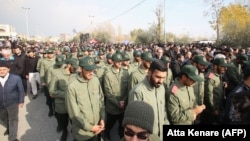Afghanistan’s four-decade-long conflict has been defined by the intervention of great powers and the meddling of neighbors who have ostensibly pursued their interests by arming or fighting various Afghan factions or facilitating their infighting.
Afghans now worry that escalating tensions between the United States and neighboring Iran following the killing of one of the most powerful Iranian generals might open a new dangerous chapter in their country’s long history of serving as a battlefield for proxy wars.
Tamim Asey, a former Afghan deputy defense minister, argues that the January 3 killing of Qasem Soleimani, commander of Iran’s elite Quds Force, could trigger a war between Tehran and Washington that will eventually foment a proxy war in his country.
“Iran has a lot of influence in the region while American [military] bases are also spread over the region,” he told Radio Free Afghanistan. “This will prompt both sides to rely on proxies.”
Asey says Tehran could push the Afghan Taliban to end peace negotiations with the United States while also pushing some Afghan political factions under its influence to torpedo the Afghan peace process.
A quarter-century ago, the hard-line Sunni Taliban emerged as mortal enemies of Iran’s Shi’ite clerical regime. This prompted Tehran to welcome and even support the U.S. attack that ended the Taliban regime in late 2001. Soleimani even reportedly implicitly coordinated with Washington in overthrowing the Taliban.
But U.S. President George W. Bush’s inclusion of Iran in an “Axis of Evil” in 2002 pushed Tehran to oppose Washington’s military presence in Afghanistan. While benefiting tremendously from regime changes in neighboring Afghanistan and Iraq, Iran continued to oppose the U.S. military presence in the two countries.
Under Soleimani, Iran’s Quds Force transformed into an exterritorial arm of Iran’s Islamic Revolutionary Guards Corps. While the organization covertly supported and fomented anti-U.S. attacks in both countries, Iranian official and diplomats denied supporting insurgencies.
The re-emergence of the Taliban as a nationwide insurgency after 2003 gave incentives to Iran to support some of its violence and extended limited support and shelter to its leaders. It is telling that the former Afghan Taliban leader Akhtar Mohammad Mansur was killed in southwestern Pakistan after returning from a trip to Iran in May 2016. Afghan and Western official claims of Iranian support for the Taliban have frequently been met with Iranian denials.
Their partnership probably also prevented the ultra-radical Islamic State from establishing a foothold in western and southern Afghan provinces sharing a 900-kilometer-long border with Iran. The two now maintain cordial open contact, with Qatar-based Taliban representatives frequenting Tehran.
Daoud Naji, an Afghan journalist, says that if Iran’s reaction to Soleimani’s killing remains limited to verbal threats, Afghanistan should be spared.
“If increasing tensions in the region result in escalating fighting, Iran will be tempted to view all U.S. military bases in the region as targets,” he told Radio Free Afghanistan. “This will prompt Iran to have Taliban as allies.”
However, he sees little chances of such an alliance because of the Sunni Taliban’s close alliance and affinity with Pakistan and Saudi Arabia in the past and historic differences between Afghanistan and Iran.
Iran’s close ideological allies in Afghanistan include but are not limited to thousands of battle-hardened fighters who have fought for Tehran in Syria since 2011 after its ally President Bashar Al-Assad faced a popular revolt.
“Iran has the capacity to utilize the Fatemiyoun Division and similar hard-line organizations against the foreign forces in Afghanistan,” noted Nazim Samoon, an Afghan analyst.
Estimated to number between 10,000 and 20,000 fighters, the Fatemiyoun Division was mainly made up of members of Afghanistan Shi’ite Hazara minority. The militia fought on the frontlines in the Syrian civil war and was believed to be founded by Soleimani.
In November 2017, Deputy Afghan Chief Executive Mohammad Mohaqiq confirmed that Iran has recruited thousands of fighters from Afghanistan and elsewhere to fight in Syria.
“I thank all the warriors who cooperated in these wars from Iraq, Syria, Afghanistan, Pakistan, and other parts of the world who attended the wars,” Mohaqiq told an audience in Tehran. “In fact, it was the war of Islam against infidelity and against the conspiracies of the world arrogance.”
Successive Afghan governments, however, have been keen on keeping a safe distance from hostilities between Washington and Tehran. In a delicate balancing act, former President Hamid Karzai and incumbent Ashraf Ghani kept Kabul away from ostensibly siding with Tehran or Washington in their conflicts.
In a January 3 statement, Afghan Chief Executive Abdullah Abdullah again attempted such an act. While offer condolences to Iran on Soleimani’s killing and acknowledging its aid to Afghans during decades of war, Abdullah also recognized his country’s strategic alliance with the United States.
“As a victim of terrorism and violence, Afghanistan has been looking for stability in the region and the world,” he said. “We hope that the recent events will not undermine the cooperation of our friends and allies in Afghanistan.”
Radio Free Afghanistan correspondents Nusrat Parsa and Ahmad Shibar contributed reporting.
